I’ve broken it all down: social media types, top platforms, and the pros and cons of each. By the end, you’ll know exactly where to focus and what to skip. Let’s dive in.
Types of Social Media
- Social Networking
- Photo Sharing
- Video Sharing
- Interactive Media
- Blogging / Community
- Micro-blogging
- Private Community
The list of social media platforms is growing, and well-known platforms like Facebook are constantly evolving and adding new features.
With a greater and greater need for a social presence and an overwhelming amount of platform choices, it can be hard to pick which social channels to use.
You might not want to spread yourself too thin by managing a channel on every imaginable platform, but you don’t want to miss great brand awareness opportunities.
1. Social Networking
- Facebook: 3.06 billion monthly active users
- X (formerly Twitter): 611 million monthly active users
- LinkedIn: 1.15 billion active users
Social networking is possibly the most traditional form of social media, and most social media platforms fall under the social networking category. So, you'll likely see at least one of the aforementioned platforms (*cough, cough* X) pop up again later in this post.
Platforms like Facebook, X, and LinkedIn are often called “networking” platforms because they allow user accounts to interact (network) in various ways.
Professional Uses
Many brands and businesses are leveraging social media direct messaging (DMs) for customer service.
In fact, our 2025 State of Marketing Report shows that 20.45% of marketers are increasing or maintaining their investment in social media DMs for customer service.
Facebook Messenger is a great platform for this strategy as it allows you to respond to messages from your brand’s Facebook followers.
Plus, as a fellow consumer, I can assure you it leaves a great impression on your customers when you respond promptly to their DMs.
There have been many times when I’ve slid into a business’ DM because I needed an update on an order, more information about a product, or troubleshooting. Now, most businesses add chatbots to respond to customers inquiries:
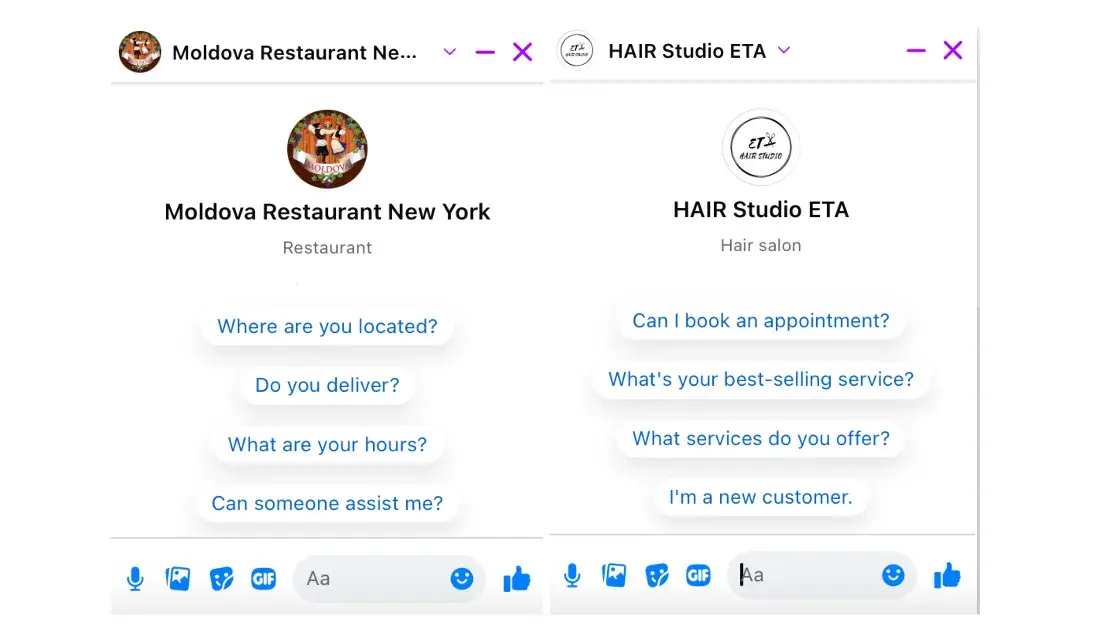
And, when the business responds back with helpful information, I always make a note to keep buying from them.
However, using direct messages benefits not only customers but also companies. For instance, Hyundai permanently integrated Meta’s Messenger into its customer service after a successful test phase. The results showed:
- A sales rate four times higher than other channels
- A conversion rate five times higher through Messenger compared to other channels
- A 13% reduction in cost per lead using Messenger
If you’re a small business, like a restaurant, I recommend a platform like Facebook as a great place to start your social strategy. With Facebook, you can build a business profile with links to your website and details about your menu.
I’m especially fond of Facebook’s community feature, which you can also leverage to create a community page for customers to ask questions or rave about your products and services.
In fact, we found that businesses that leverage social media communities will see excellent results in their marketing strategy.
According to our survey, 90% of marketers say building an active online community is crucial to a successful social media strategy.
I'm not surprised, considering our Consumer Trends survey found that 20% of social media users joined an online community in the past three months, and 22% actively participated in one.
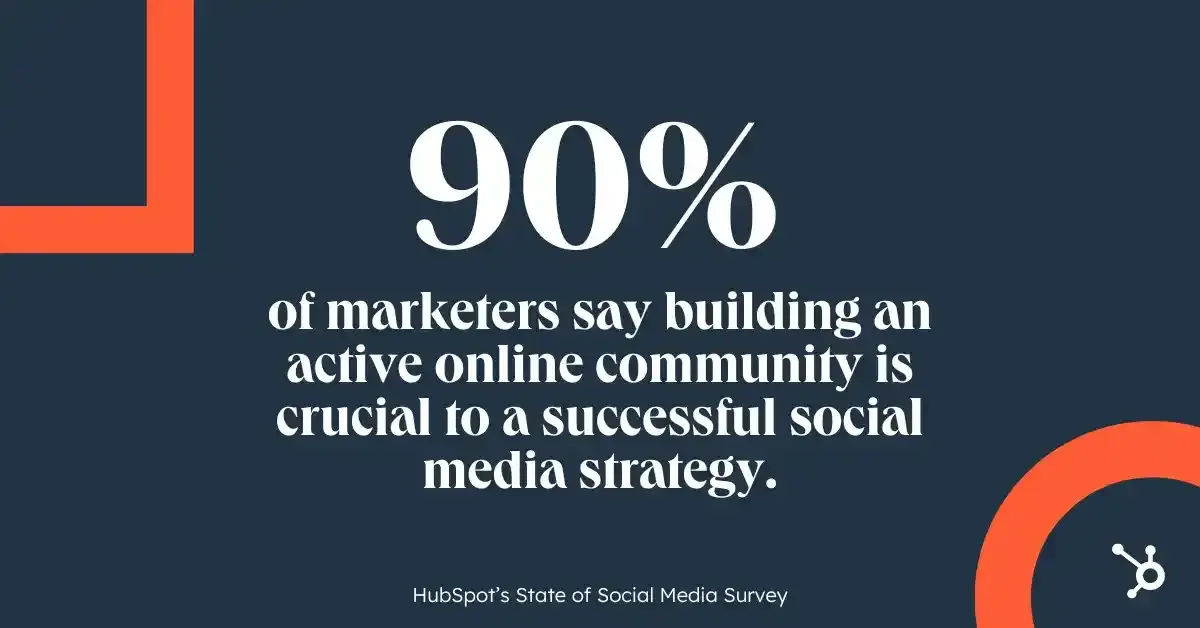
One of the best Facebook groups I’m in is run by Kat Sullivan, who saw a gap in how group creators engaged with members.
Kat openly shares insights from working with business owners and agencies, while members contribute by discussing entrepreneurship, dissecting online monetization, and sharing interesting marketing case studies.

LinkedIn emphasizes career-related networking, and, for years, I only ever used LinkedIn when searching for jobs or to help friends find opportunities. It turns out, however, that LinkedIn is very beneficial for businesses.
For companies looking to offer a professional service, such as B2B or publishing companies, LinkedIn is another excellent way to grow a following.
What I love about LinkedIn is how it evolved — it’s no longer just a stiff corporate platform. Brands like Semrush and Hootsuite have nailed the balance between professionalism and humor while staying true to their niche. It’s a genius way to get people to resonate with your content, love it, and keep coming back for more.
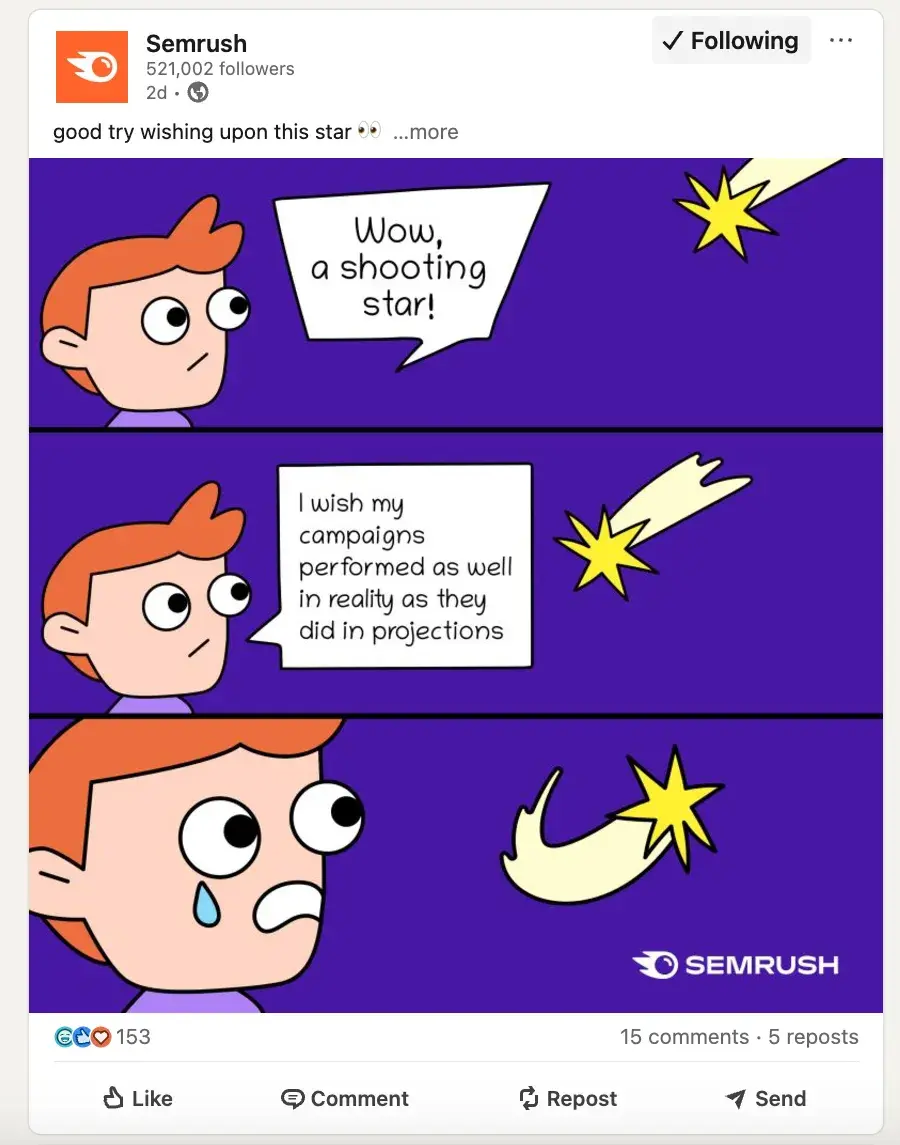
According to our survey, LinkedIn is among the top five social media platforms yielding the highest ROI for marketers.
Furthermore, of the marketers who currently leverage LinkedIn in their strategy, 26.16% plan to increase their investment in 2025.
Brands looking to build an audience of professionals from a particular industry can create a business profile there, categorize it with an industry type, and then use posts and messaging to publish updates. They can also use messaging and comment features to interact with their audiences or users who comment on their posts.
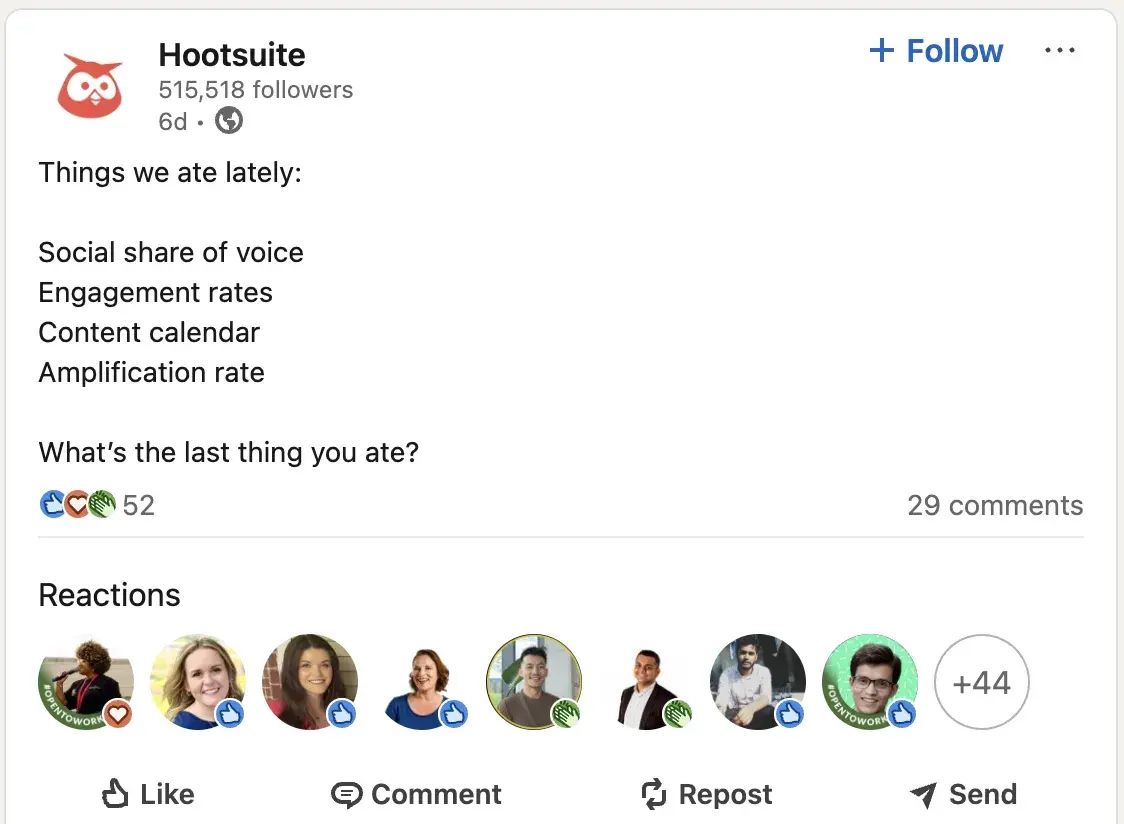
Besides organic traffic, let’s not forget LinkedIn advertising options. Jaimon Hancock, Founder & Digital Strategist at Adalystic Marketing, shared how LinkedIn ads can work wonders for B2B clients:
“For a B2B client facing high competition and rising CPCs, we saw an opportunity to improve LinkedIn ad performance. To boost engagement and lower costs, we layered in LinkedIn Thought Leadership Ads, promoting content from an individual’s profile instead of the company page. This approach made the campaign feel more organic and authentic. One of our top posts featured an executive accepting an industry award, subtly boosting credibility without pushing sales.”
The results are impressive:
- 50% lower cost per conversion.
- 5x higher click-through rate (CTR).
- 75% lower CPC.
- Meaningful engagement in the comments.
X (formerly Twitter)
An X account could be helpful to companies in a broad spectrum of industries, from entertainment to e-commerce. This platform similarly allows you to create a profile where you can list and link company information.
You can then use X to post about company updates, tag companies or customers in posts, repost positive customer tweets, and respond to customer questions via posts or direct messages.
One of my favorite X features I think marketers should look into is Spaces, which allows users to create live audio chat rooms and talk amongst each other.
Companies will often use Spaces to host Q&As, interview thought leaders, or keep audiences informed about the latest happenings with the brand or industry.
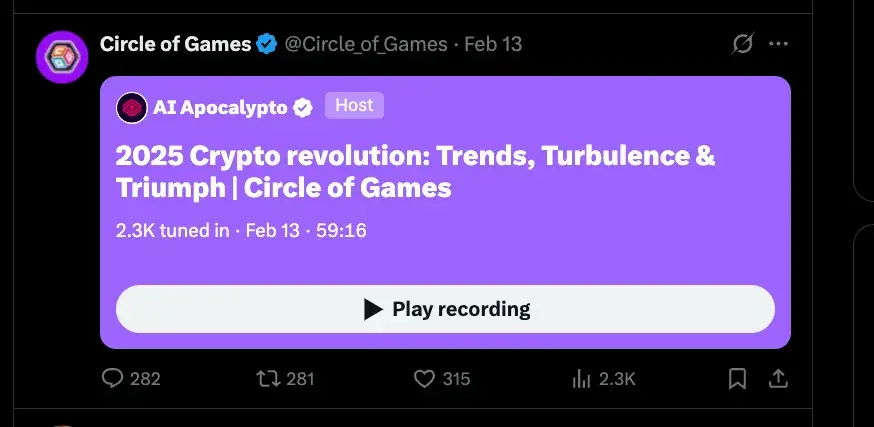
On all three social networks, users can easily communicate with others through simple actions like tagging, hashtagging, commenting, private messaging, reacting to posts, and re-sharing content.
Aside from social interaction, feeds on common social networking platforms are designed to show off a mix of text and visuals rather than one primary content type.
This flexibility makes it easy to begin a social strategy on social networking platforms because you can experiment with different forms of content before branching out to platforms that require more specific content types. For those who want to dabble in video or graphics, these platforms could be a great place to test this new content.
With the growth of video marketing, many have begun to launch more advanced features like Facebook Stories and X’s live streams. They also started encouraging native video and photo uploads more heavily.
Recently, Facebook adjusted its algorithms to favor live video and image uploads. This has caused these types of native content to gain greater user engagement.
And no, Reels aren’t just for Instagram anymore. Facebook now has its own Reels section, mixing all kinds of videos based on its algorithm. And looking at the numbers, they’re outperforming images and text content by far.
The best example is the Northwoods Folk Facebook page. She’s a nature-inspired influencer who shares practical tips and tricks. Let’s take a look at her photo content, which typically got around 20–30 likes with minimal engagement:

And then we have reels:

This speaks a lot about the changes happening on platforms and how Facebook has also gone in the video direction.
If you’re unsure where to start, check out our beginner’s guides for Facebook, X, and LinkedIn.
I'll be honest, the beginner guide for X was published before the platform rebranded from Twitter; however, much of the information still applies today.
Pros and Cons
Pros
- Facebook, X, and LinkedIn are some of the most prominent forms of social media.
- Social networking sites often integrate with scheduling tools like HubSpot and Hootsuite software.
- All platforms have capabilities for photos and video.
Cons
- Those interested in posting links may have more difficulty getting engagement than uploading photos and videos.
- Some platforms, like Facebook, put individual user posts higher than business posts in newsfeeds.
- Facebook may not be the right platform for your business if you're looking to target younger consumers like Gen Z, who are more likely to use TikTok, X, or Snapchat.
2. Photo Sharing
- Pinterest: 533 million monthly active users
- BeReal: 23 million monthly active users
Photo-sharing social media platforms are exactly as they sound — they're platforms where sharing images is the name of the game. I remember the days when Instagram was the most prominent photo-sharing platform.
But that was then, and this is now, so if you’re wondering why Instagram isn’t mentioned here — don’t worry! I’ll have more on that when I get to the video platforms.
Professional Uses
One of the biggest platforms that specialize in photo sharing is Pinterest. Pinterest is a “visual discovery engine” for users looking for cooking, style, home decor, and general visual inspiration.
Personally, I’ve been using Pinterest for over 10 years and, like most users, I interact with other accounts on the platform through tags, likes, comments, or direct messages.
In the early days, Pinterest wasn’t as synonymous with brands and companies as it is now. Here’s how it looked:

It was more so about crafting virtual vision boards based on aesthetics.
However, brands, companies, and creators find it useful when they want to take photographs, display content, and update followers about their food, goods, or products.
Pinterest is well-suited for e-commerce companies, such as those that sell home goods and businesses that would like a place to share crisp standalone product images with links.
The platform offers a photo-based feed with posts that can include a photo and a short description.
In the last few years, Pinterest has also shifted to include more video content to compete with platforms like Instagram Reels and TikTok. However, the platform still remains a place for users to share their favorite photos.
Here's a little look at my Pinterest feed.

The platform also allows all users to link directly to websites or product landing pages in posts. I especially love Pinterest‘s Explore page and can see a lot of opportunities for brands there. The Explore page updates daily and operates almost like an old-school blog, with the ability to scroll to see the previous days’ themes as well.
It features boards curated by celebrities, creators, and brands sharing images their followers would be interested in. And, of course, there are opportunities for consumers to shop.
I clicked on the board called Pinterest Predicts: Dolled up 2025 and was shown different trends expected to take over this season, along with links to buy them.

Before starting on a platform like Pinterest, you’ll want to determine whether your goal is to gain brand awareness or link-based or e-commerce traffic.
BeReal
If you haven’t heard of BeReal, I don’t blame you. It's a fairly new app that launched in 2020 and is pretty popular among Gen Z users.
The app's main feature is that it allows users to share a photo of themselves and their immediate surroundings during a randomly selected two-minute window every day.
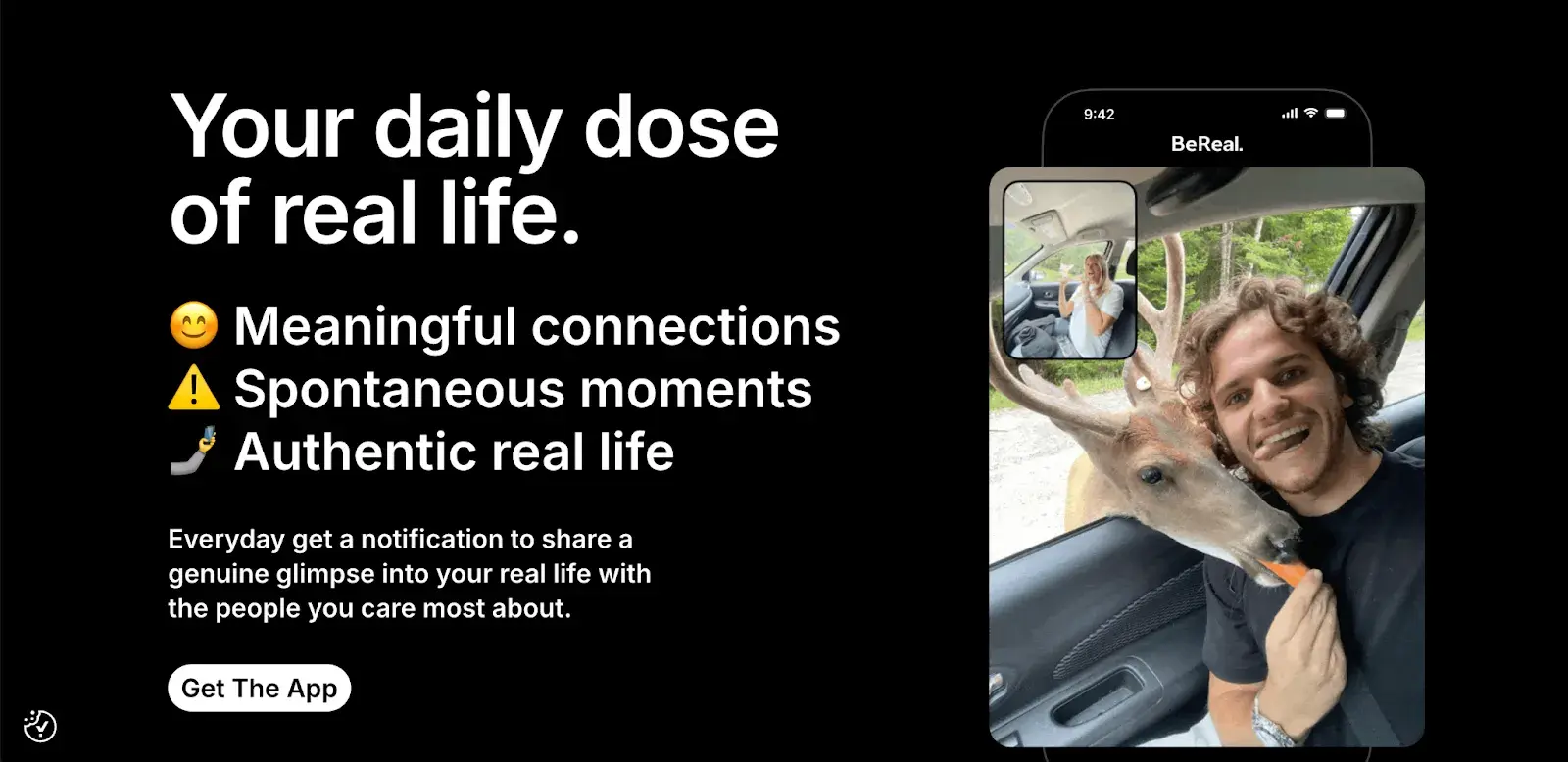
The idea of BeReal is to step away from the overly filtered and curated content users often see on other platforms. Just be real. Get it?
With the app's premise being candid and unfiltered, how can brands leverage BeReal? The best way I could think of is to use the app to build trust with your audience and only share behind-the-scenes candids.
However, that can be difficult, given users are only given a random two-minute window to post.
Pros and Cons
Pros
- These kinds of platforms help with brand awareness. Approximately 80% of Pinterest users say they’ve learned about products or services on the app.
- Pinterest provides an outlet for showing off visual content or product shots.
Cons
- Upkeep on these platforms might require a photo budget or dedicated production time.
- Some platforms require you to post from a mobile app.
- BeReal is most popular with Gen Z users, and there is no opportunity for e-commerce or paid content on the app.
3. Video Sharing
- YouTube: Over 2.7 billion monthly active users
- Instagram: 2 billion monthly active users worldwide
- TikTok: Over 955 million monthly active users
Video has been the dominant type of content marketing over the last few years, and it has no sign of slowing down — especially short-form video.
17.13% of the marketers whose companies are currently leveraging short-form videos say they will increase their investments in 2025.
Adding a video platform to your social strategy could make your brand look relevant and keep you up to speed with your competitors. Video can be helpful to a wide range of industries. While a restaurant could have a vlog with cooking tips, a technology company might focus its video strategy on product demos.
Professional Uses
YouTube & Vimeo
YouTube offers both short-form and long-form capabilities.
Regarding short-form video uses, YouTube Shorts can be a platform your business uses to post product demos, explainer videos, and more.
If you want to get interactive, you can also host live-stream Q&As to answer consumer questions and build community.
When it comes to long-form videos, YouTube is one of the leading platforms. Compared to competing video-sharing platforms like Vimeo, YouTube has an extensive audience base and better SEO capabilities.
What’s great about YouTube’s long-form format is that you can create content series — episodes that are either standalone or built on each other.
When your audience knows a new video will drop every two days, let’s say it keeps them coming back and makes them more loyal. Just like how people eagerly wait for the next episode of their favorite TV show, it's pretty much the same with this.
As for educational videos, my favorite is the Ahrefs series hosted by Sam Oh, covering everything from blogging to all things marketing and SEO:

Janelle Warner, co-director and marketing advisor at Born Social, shared how YouTube played a crucial role in their campaign's success:
“I vividly remember the day we launched the influencer component — it was like a wildfire spreading across social media. The top tech YouTuber we partnered with did an unboxing video that got over 2 million views in the first week. The comments were incredibly positive, with people tagging friends and saying they needed to get this product. It demonstrated the power of tapping into established, trusted voices in your industry.”
However, it wasn’t just YouTube that contributed to this success — it was a multi-pronged approach. A combination of influencer marketing, engaging video content, and targeted ads.
- By partnering with popular tech influencers, they reached a highly engaged audience and built credibility.
- Their video ads showcased the product’s features in an entertaining way, encouraging views and shares.
- Targeted ads on Facebook and Instagram helped them focus on their ideal audience.
Over 500,000 engagements, 100 million video views, a 20% increase in website traffic, and a 400% return on ad spend in just 3 months. What a result!
So YouTube definitely has amazing opportunities for advertisers and monetization, while Vimeo offers viewers the perk of no pre-roll ads. For a longer list of similarities and differences, check out this head-to-head piece where we compare the business capabilities of Vimeo and YouTube.
To compete with TikTok, Instagram has shifted away from being a photo-sharing app.
While users can still post photos on Instagram, the platform mainly promotes reels and video stories. It's also worth mentioning that Instagram video posts are more than twice as likely to generate engagement than image posts (kinda similar to what we’ve seen with Facebook above).
And when you figure out how to serve up content your audience can't get enough of, you can get tons of views overnight (literally!).
Best proof? One and only Duolingo:
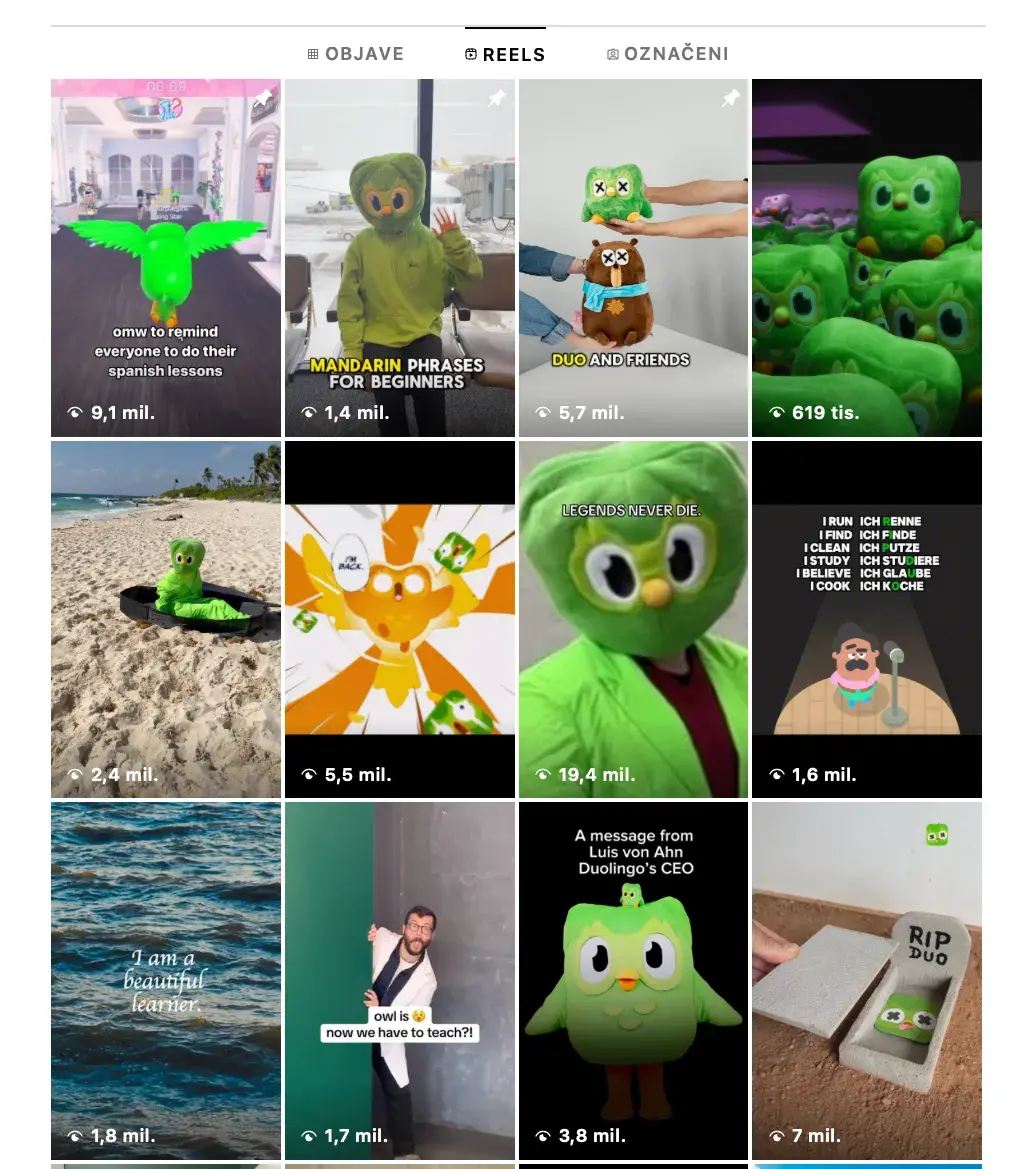
Another example of how powerful shorts and reels can be came from Karen Etchells, Digital Marketing Strategist at Innovast Digital Marketing.
She embedded vertical videos in blog posts, then repurposed those videos as YouTube Shorts, Instagram Reels, Facebook, and TikTok clips to reach a wider audience.
YouTube Shorts alone led to a 2x boost in site visits from video searches. They saw a huge jump in engagement and overall visibility — a 73% increase in search engine traffic.
TikTok
I’m going to revisit TikTok again later in this post because it also falls under another category of social media platforms. However, it is still a video-sharing channel.
What I love about TikTok in terms of marketing is that it’s a very diverse app with many marketing opportunities.
Yes, you can post short-form demos and explainers, like on Instagram Reels and YouTube Shorts, but TikTok has more opportunities to build community with your audience.
This is because the app is a breeding ground for new viral trends anyone can take part in, and the app provides many ways for audiences to interact via liking, commenting, repurposing sounds, and stitching — the ability to respond to someone’s video by filming your own.

For example, check out how the Chicago Bulls mascot, Benny the Bull, responded to the NBA using Stitch:
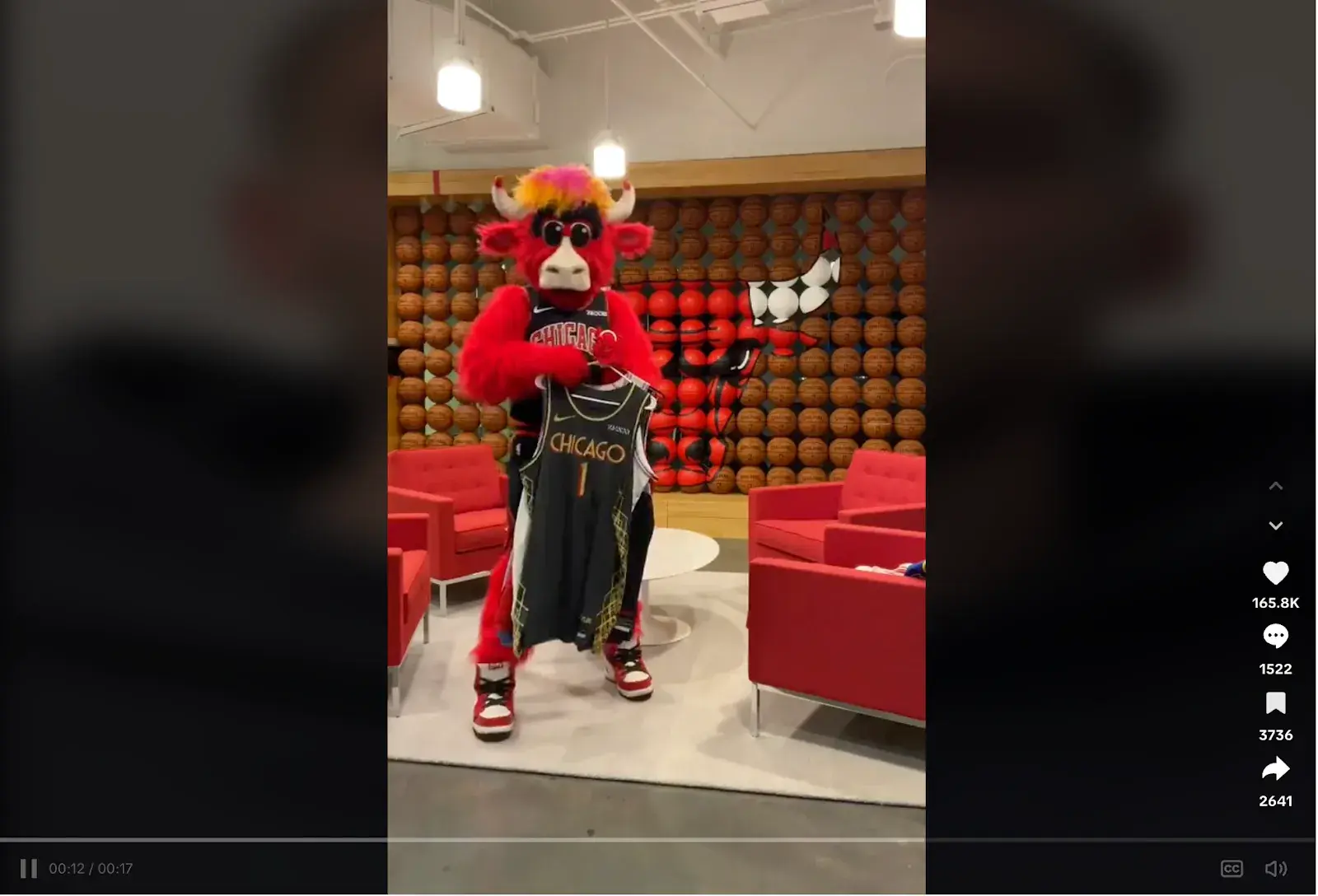
P.S. No offense to any teams, but this video is going down as one of the most legendary stitches ever.
Let’s dive into TikTok’s interactive opportunities.
Pros and Cons
Pros
- Regarding YouTube, videos can be longer than on other social platforms.
- All platforms have website linking capabilities.
- Platforms like YouTube, TikTok, and Instagram often offer analytics.
- YouTube has search optimization features.
Cons
- Video content, particularly long-form, might take more time and money to create.
- Vimeo and YouTube require more backend tasks, like SEO.
- Instagram does not have long-form video capabilities
- TikTok appeals to a younger audience known to distrust brands, so you will likely have to invest in influencer marketing to gain traction on the platform.
4. Interactive Media
- Snapchat: 850 million monthly active users
- TikTok: Over 955 million monthly active users
Apps like Snapchat and TikTok allow users to share photos and videos and have various unique interactive and highly experimental features.
These two apps include AR/VR filters, musical overlays, and interactive games. Their audience base is also predominantly Gen-Z.
Professional Uses
Snapchat
Brands with large followings might consider publishing Snapchat Stories or videos curated by fans. Without a high-budget or giant online following, it might be difficult for a company just starting out on social media to leverage Snapchat.
Brands and influencers on Snapchat tend to cater their content to the platforms’ younger audiences. For example, on Snapchat, you might see stories that present beauty tutorials, wellness tips, news, or trendy new products.
While major brands, like VICE and BuzzFeed, have become Snapchat Discover partners, the average business can still create a Snapchat business account that users can search for and friend.
This account allows you to publish temporary stories like individual accounts. However, those with a business account can also purchase ad space.
For example, Clarins boosted its sales with Snap Ads, Collection Ads, Dynamic Ads, and UGC content.
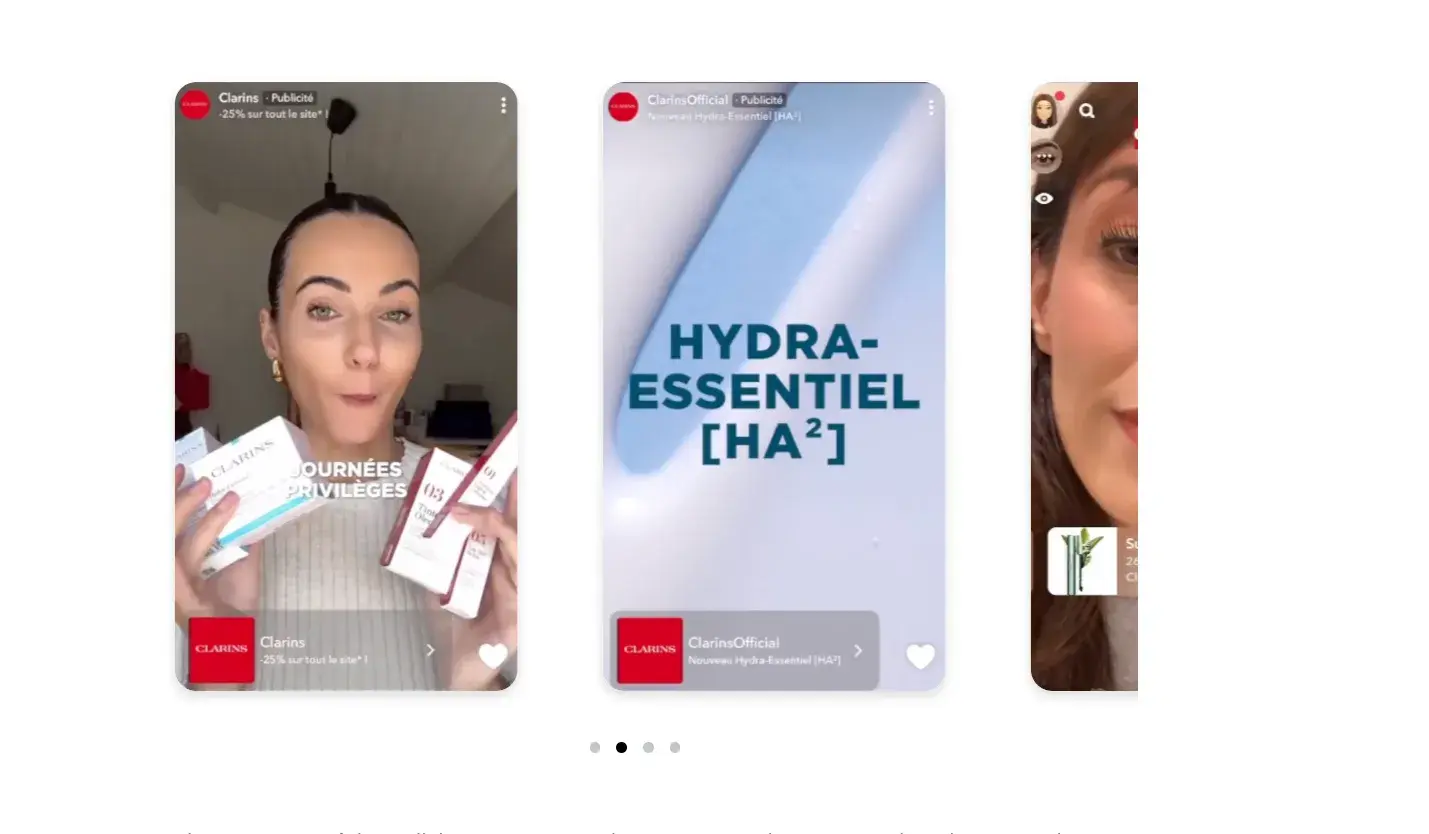
They optimized their Snapchat strategy, driving a 114% increase in website actions and a 67% return on ad spend from new audiences. Their efforts led to a 275% rise in incremental sales and an 83% increase in Snapchat ad spend, proving the effectiveness of the whole strategy.

If you’ve set up your Snapchat account and need further help, check out this guide to getting started on Snapchat.
TikTok
When TikTok first rose to prominence in 2020, it was mainly an app-based platform catering to a Gen Z market that wanted little to do with brands.
Since then, TikTok has grown to shift its focus to longer-form content, and brands are much more aware of how to leverage the channel.
In fact, about a quarter of marketers in our Social Media Marketing survey say TikTok yields the highest ROI compared to other social media platforms.
What’s wild about TikTok is that some videos can get millions of views, while the next one might get stuck at 200. But, speaking from experience, don’t give up because TikTok really rewards creativity and consistency.
The key to TikTok is to invest in influencer and creator marketing. Build a partnership with a creator who aligns with your brand's values and can introduce your products and services to their audience.
We mostly come across two types of influencer collabs on TikTok:
1. Subtle, non-pushy marketing. For example, check out how Zach King promotes Mr. Nova’s ice creams without even saying a word about it.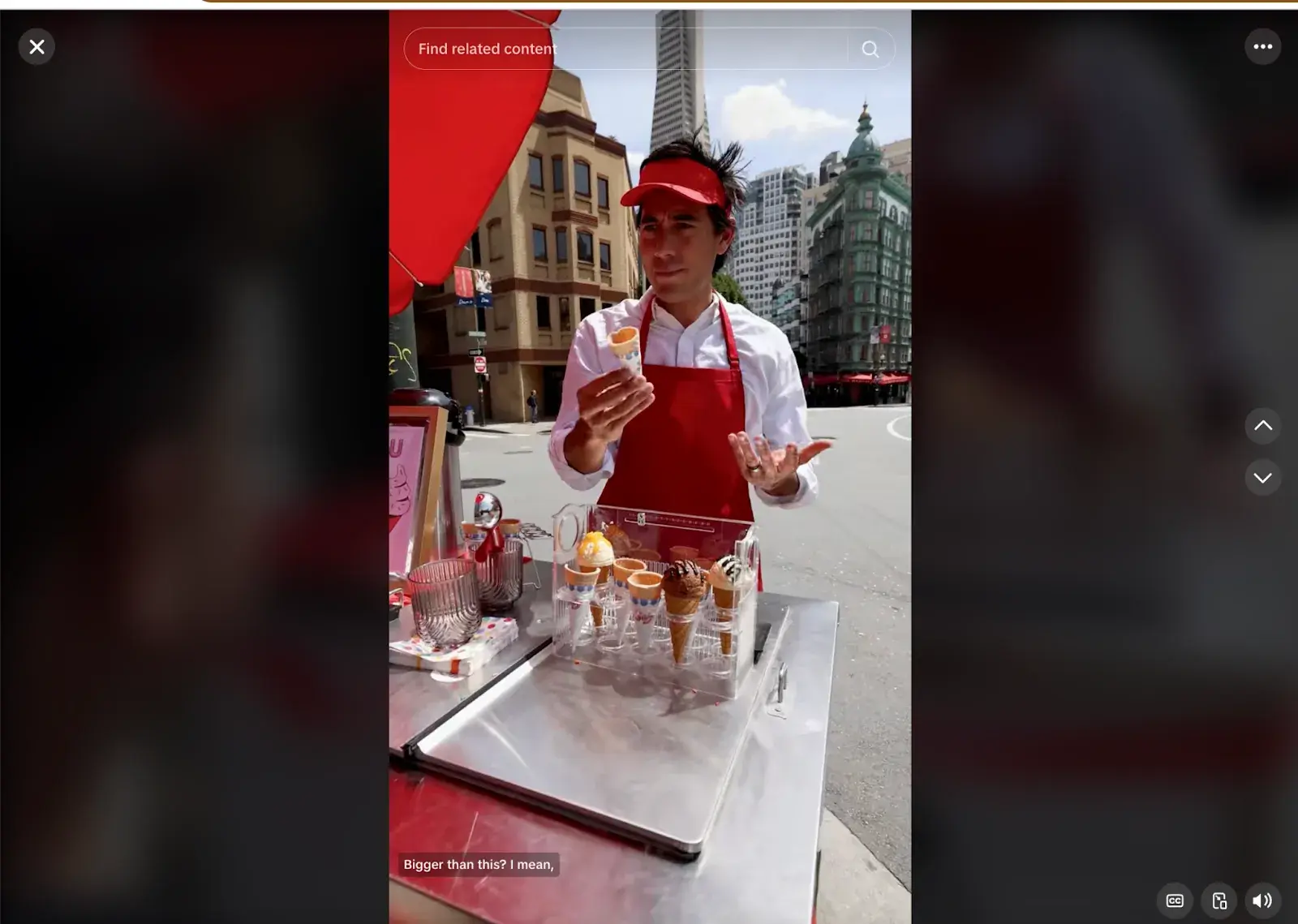
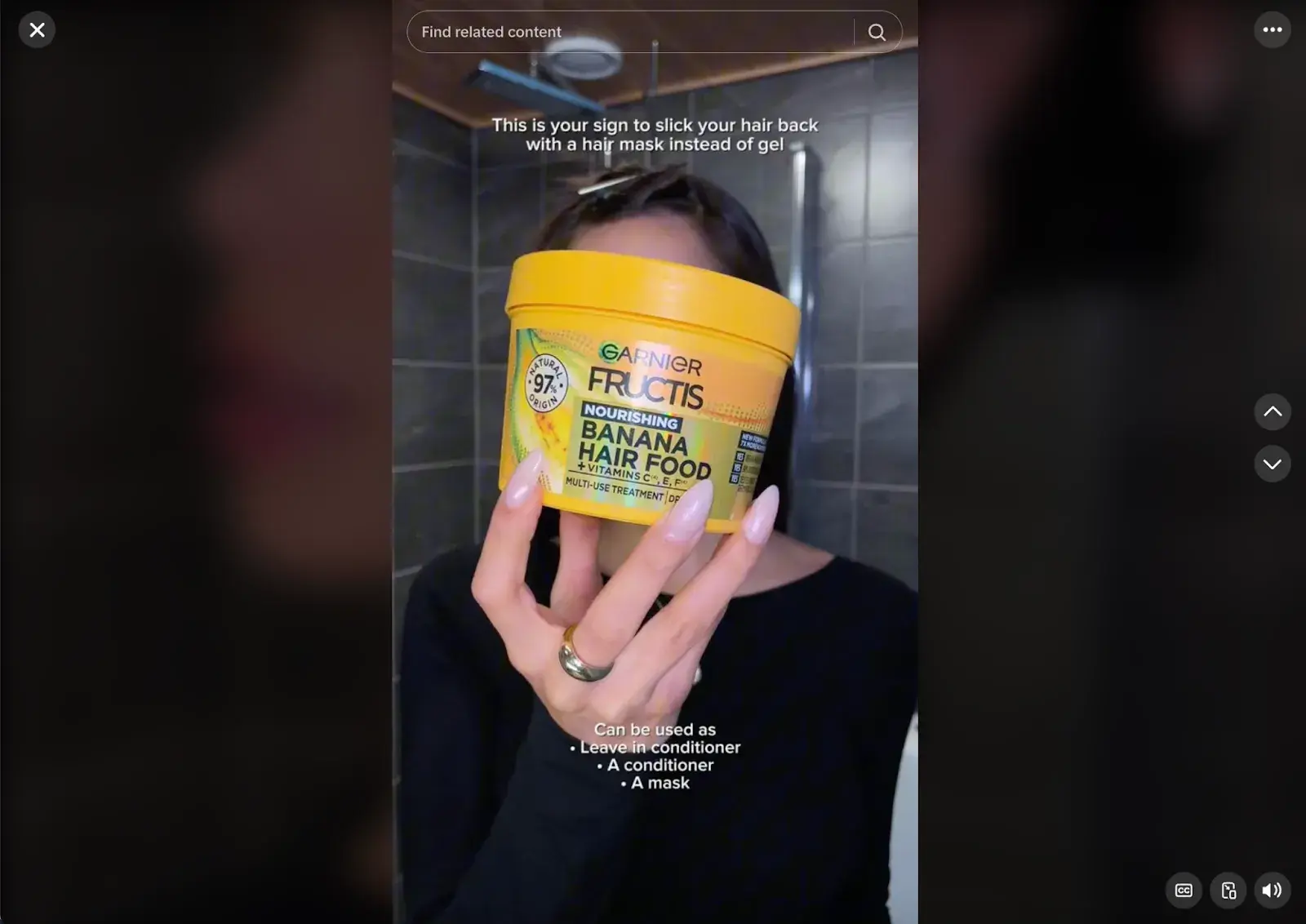
But, influencer marketing also gives room for experimentation. We often take risks, try something new, and just pray it works.
Austin Benton, Marketing Consultant at Gotham Artists, was brave enough, and it paid off. Here’s what he did:
“Instead of paying influencers for traditional sponsored posts, we sent PR packages to 20 micro-influencers (10K-50K followers) with a challenge: film an unboxing and reaction video, and if your post gets 500+ likes, we'll send you an exclusive mystery VIP package.
This small tweak made a huge difference because it turned the campaign into a game rather than just another product promotion. Influencers were naturally more excited to post, and their followers got curious about both the product and the “mystery reward,” which drove engagement through the roof.”
312% increase in sales and a 270% boost in engagement within six weeks. Impressive results!
Austin also said that after launching the challenge, they encouraged customers to post unboxing videos for a chance to win a year's supply of the product, which created massive FOMO and boosted UGC.
They ran retargeting ads featuring viral videos, resulting in a 5.4x return on ad spend (ROAS).
Pros and Cons
Pros
- These platforms are very creative and experimental.
- They have young audiences, which can help brands better target Gen-Z.
Cons
- Producing regular content could be expensive and time-consuming.
- Business accounts aren’t promoted up-front on the Snapchat interface. You may want to promote your channel on your website or other social channels because users must search for you with your Snapcode or username.
- Snapchat is limited to mobile and isn't as easy to use as other platforms.
- You will most likely have to invest in influencer marketing to gain traction on TikTok, and finding a creator aligned with your business may be difficult.
Pro tip: You should try to correctly estimate the time and money that might go into keeping these accounts up-to-date and relevant.
If you're unsure how short video ads can benefit your business, remember that short-form videos have the highest ROI compared to other video formats.
5. Blogging/Community
- Tumblr
Tumblr and Reddit allow users to post about exciting niche topics, like memes, events, politics, and pop culture.
When users publish a post, these platforms allow others to share it or add it to the conversation with their commentary.
Professional Uses
Both blogging and community-building platforms could be helpful to those who want to encourage discussion around very niche industries or topics.
For example, on these platforms, you might see discussions about anything from alternative health to machine learning.
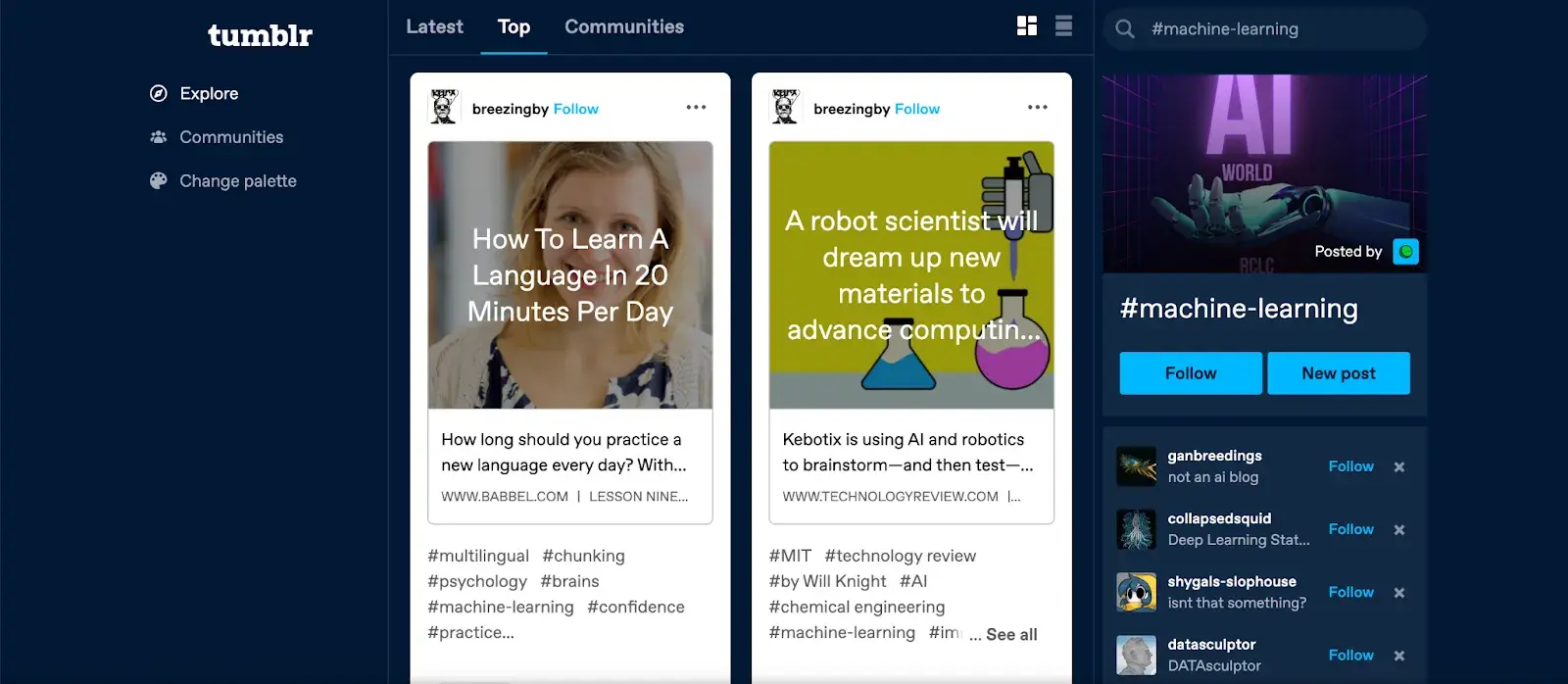
By blogging, you can write posts about your company’s industry topics and link them to your product or site.
While many people have a blog on their website, platforms like Tumblr might be great to use if you haven’t set this feature up — or just want to see what others in your industry are blogging about.
With a discussion site like Reddit, you could share a link or a post about a specific topic on a discussion board related to your industry and see how users respond. You could also start your board if a topic you’re looking to encourage discussion on doesn’t have one yet.
These two platforms specifically encourage web chatter and post shares from users who care about the same topics.
Both also allow users to follow you or subscribe to your blogs or Reddit boards so your content can appear on their feeds. Here’s an example of what Reddit’s feed looks like.
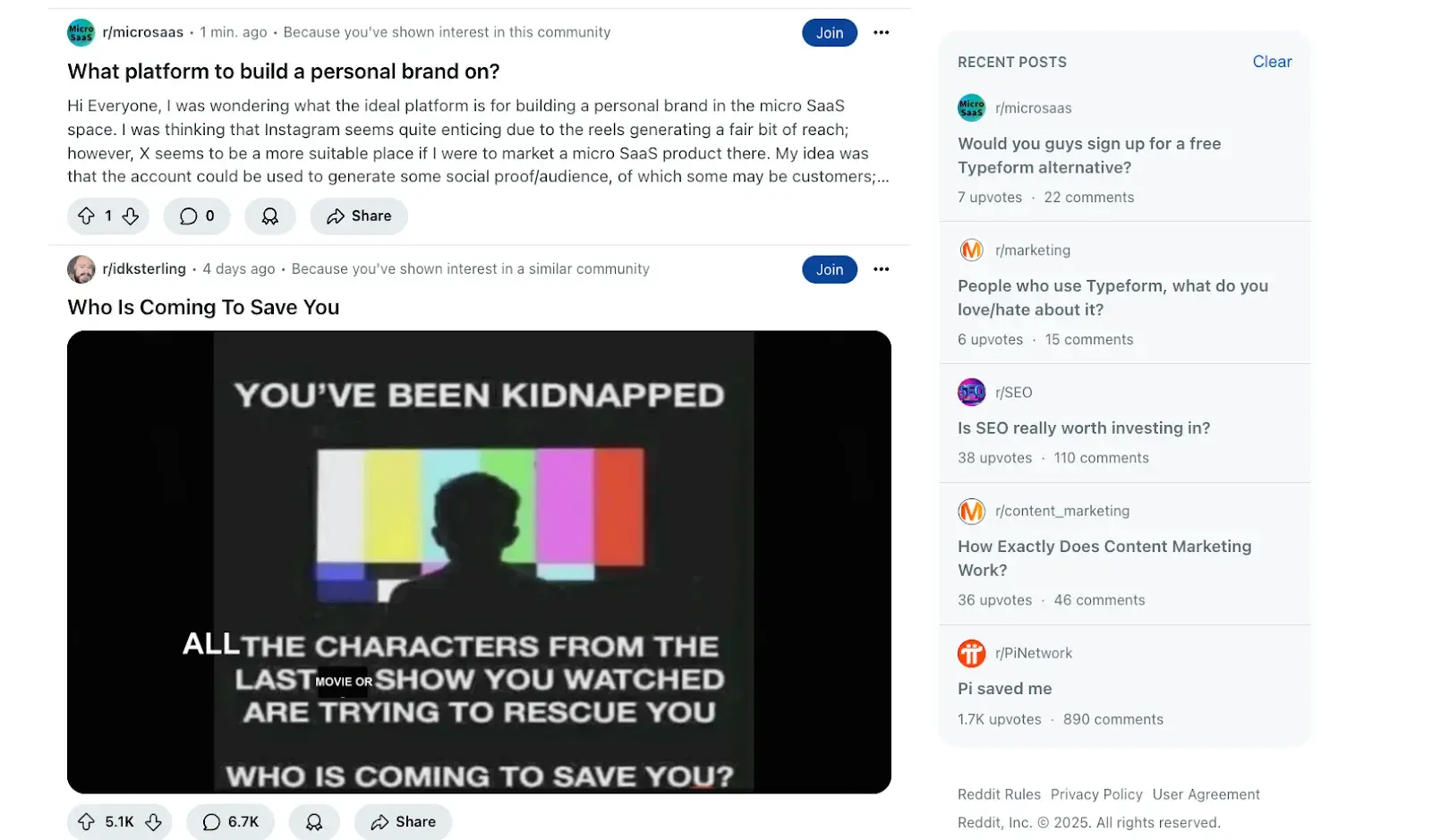
Other users can up-vote or down-vote when someone publishes something on Reddit. Up-voting makes a post show up higher in Reddit feeds, while down-voting does the opposite.
On Tumblr, the feeds are organized by time. However, a post can show up higher when it is re-shared by other users. When a user shares or interacts with your Tumblr content, they give it a note.
When they reshare, they can post a comment with the post that gets added to a thread.
Pros and Cons
Pros
- Both platforms allow you to share text posts, photos, and videos about your business, brand, or individual thoughts.
- These platforms enable you to start conversations about a topic.
- Both platforms allow linking to outside websites.
Cons
- Longer blog posts might take time to craft or write.
- Getting downvoted on Reddit or having no reaction from Tumblr users means your posts may go unseen.
- Your audience might be too niche or limited to just those on the specific platform you use.
6. Microblogging
- Threads: 130 million monthly active users
- X (formerly Twitter): Over 320 million monthly active users
Microblogging refers to posting short blogs that are meant for quick audience interaction. Both Threads and X fall under this category as they allow users to post blog content with very limited character counts.
Professional Uses
For years, companies have used X to post quick updates regarding their products and services or to engage with their audience in a humorous or relatable way. For example, Wendy's will often post content like below to humorously entice their audience.

The same can be said about Threads, though the platform has only been around since July 2023.
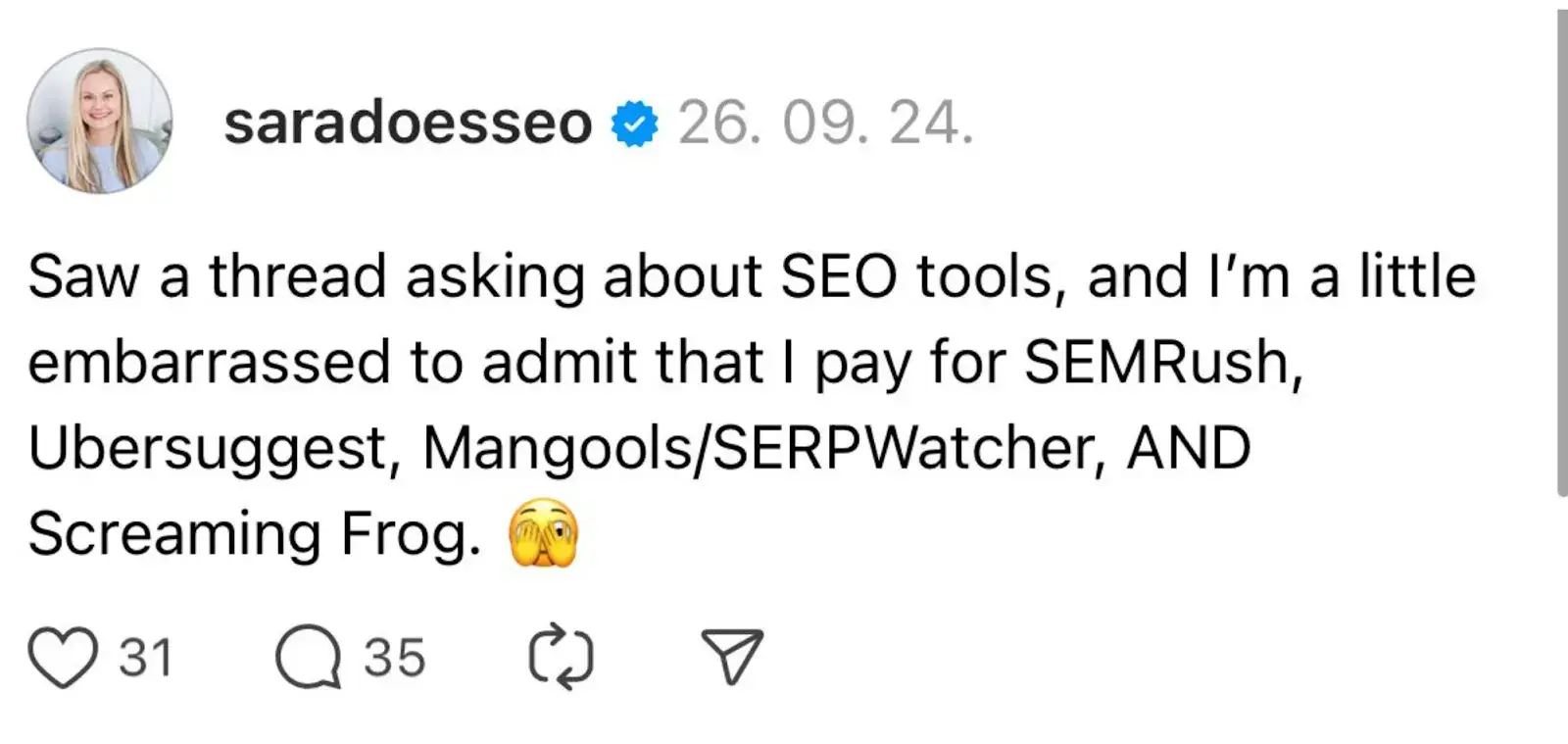
Both platforms allow users to upload mini blogs, photos, and videos to engage audiences. So, really the possibilities are endless in terms of how to use the platform.
Pros and Cons
Pros
- If you have a great sense of humor (like whoever runs Wendy's social media), you have a great chance of entertaining audiences and raising brand awareness on microblogs.
- Microblogs are very versatile in terms of the kind of content you can post.
Cons
- Since rebranding from Twitter, X has been experiencing a steady decline in users.
- Threads also struggled to maintain consistent users and has yet to eclipse X, its direct competitor.
7. Private Community
- Discord: 200 million monthly active users
- Slack: 79 million active monthly users
One of the best ways to build a loyal customer base is through platforms like Discord and Slack. They give you a direct line to your audience — share exclusive content, start conversations, build trust, and turn followers into a tight-knit community.
Professional Uses
Discord
You can use Discord as a virtual focus group where you can engage with your consumers directly to understand their habits, concerns, and needs.
B2B brands and SaaS companies can benefit from Discord if they play it right.
For instance, Midjourney used the platform’s engaged community to fuel growth. Their app, which lets users create AI-generated images, has turned into a hub for creativity and collaboration.
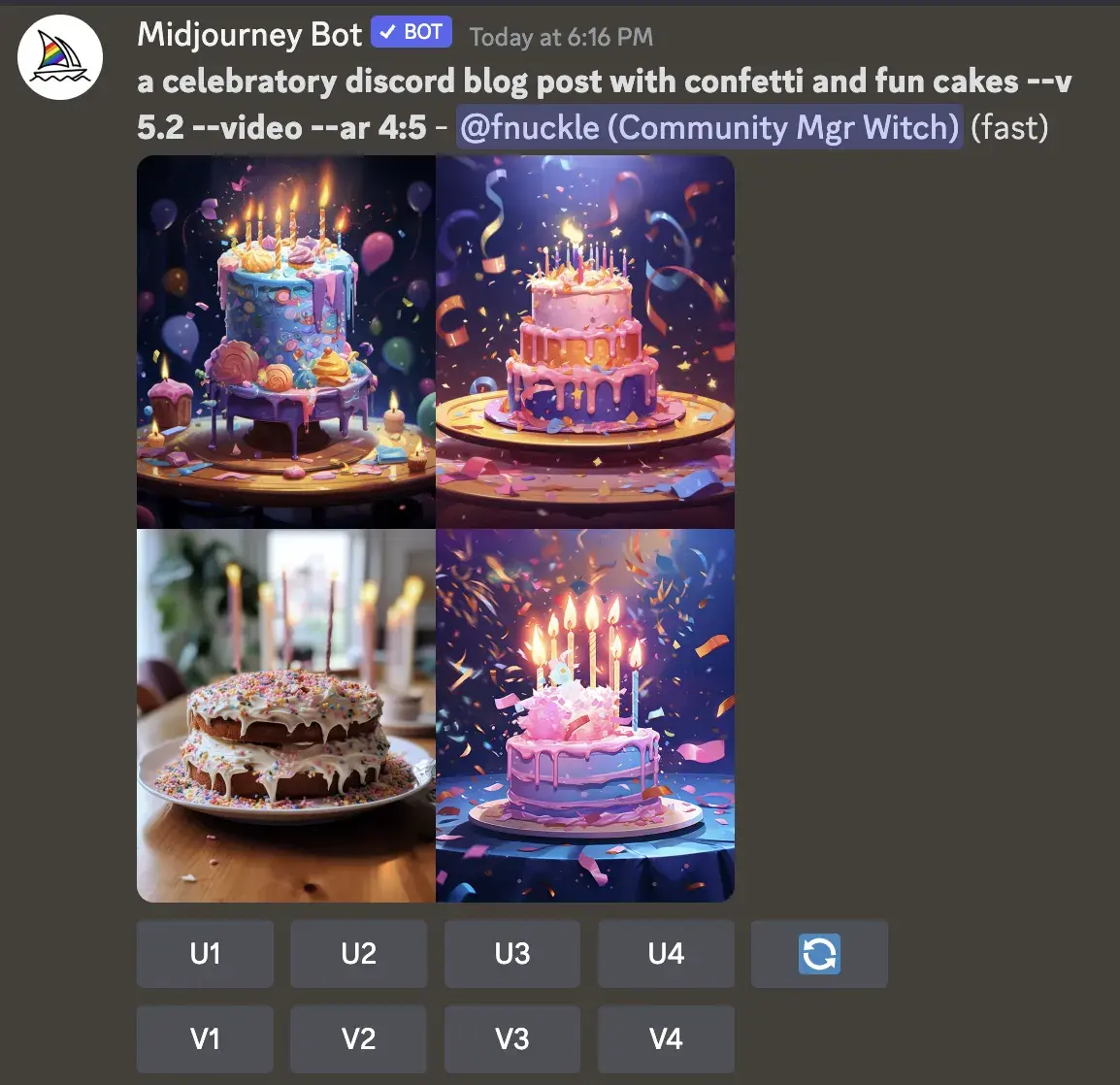
The numbers speak for themselves:
- 1 million users in just three months after private testing
- Thousands of new users daily at its peak
- Installed on 7 million servers
- The server hit a cap of 1 million users.
I also have a Discord server, and I use a content creator to engage with my followers, keep up with the latest happenings in my niche, and build community.
Few things are more frustrating and terrifying to me than when I post something on social media that is meant for my friends, followers, or my target audience, and it “leaves the neighborhood.” By that, I mean the post leaves its intended audience and takes on a life of its own.
Discord is a voice and chat platform where users join conversation servers, often through exclusive invites, and talk to other members about niche topics.
Slack
Slack has gone from just a basic team communication channel to a powerhouse for all sorts of fields, like SEO, marketing, and more. There are many free groups like BigSEO, but you usually need to sign up or request access (which is actually great since it helps keep spam out).
There are also some paid channels. For example, the DO link building community by Digital Olympus offers both free and paid options to connect SaaS editors and SEO experts with exclusive access, collaboration opportunities, and even mentorship.
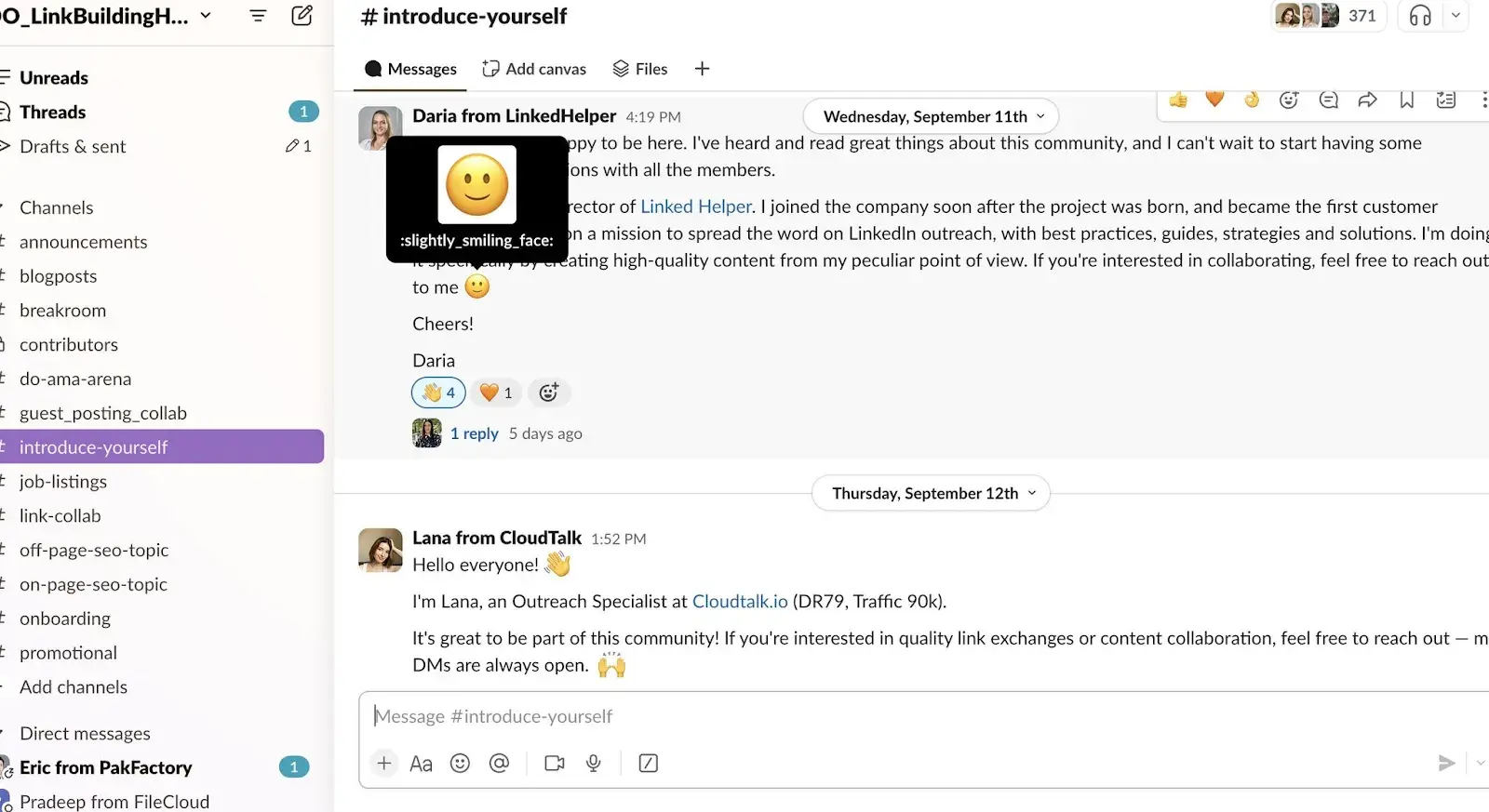
So, some channels are definitely worth paying for. Of course, it’s necessary to do a little research, see user experiences, and understand what benefits you can gain before deciding to give a paid channel a chance.
Pros and Cons
Pros
- Like I said, private community platforms are excellent for community building with your followers and like-minded individuals. You can foster community and stay tapped into your audience.
Cons
- Discord doesn’t have features for native advertising, and it’s only really helpful if you already have a stable audience who wants to be in the community with you. So, you may have to focus on building your brand's following before investing in Discord.
- Slack has a message limitation — it allows you to search the last 10,000 messages only. So, if you‘re trying to search for something older than that, you won’t be able to find it.
From TikTok to LinkedIn: Where should you be?!
Every platform has its benefits, but definitely not equally for everyone.
That’s why before you start building a community anywhere, figure out where your audience actually is.
For B2C, Instagram, TikTok, and Facebook will always be a solid bet. On the other hand, for B2B, LinkedIn, X, and communities like Slack or Discord might work.
Of course, there are no hard and fast rules. A SaaS company can absolutely share quick tutorials on TikTok or Instagram. The trick is knowing who you’re targeting and giving them the content “they’re hungry for.”
And yes, as the internet evolves and so do the types of content people prefer, I’m glad you’re still reading this. It means that despite the flood of video content, some people still love a good, old text post.
Keep up with trends, but stay true to yourself. That’s the recipe for success.
Editor's note: This post was originally published in June 2019 and has been updated for comprehensiveness.

.png)
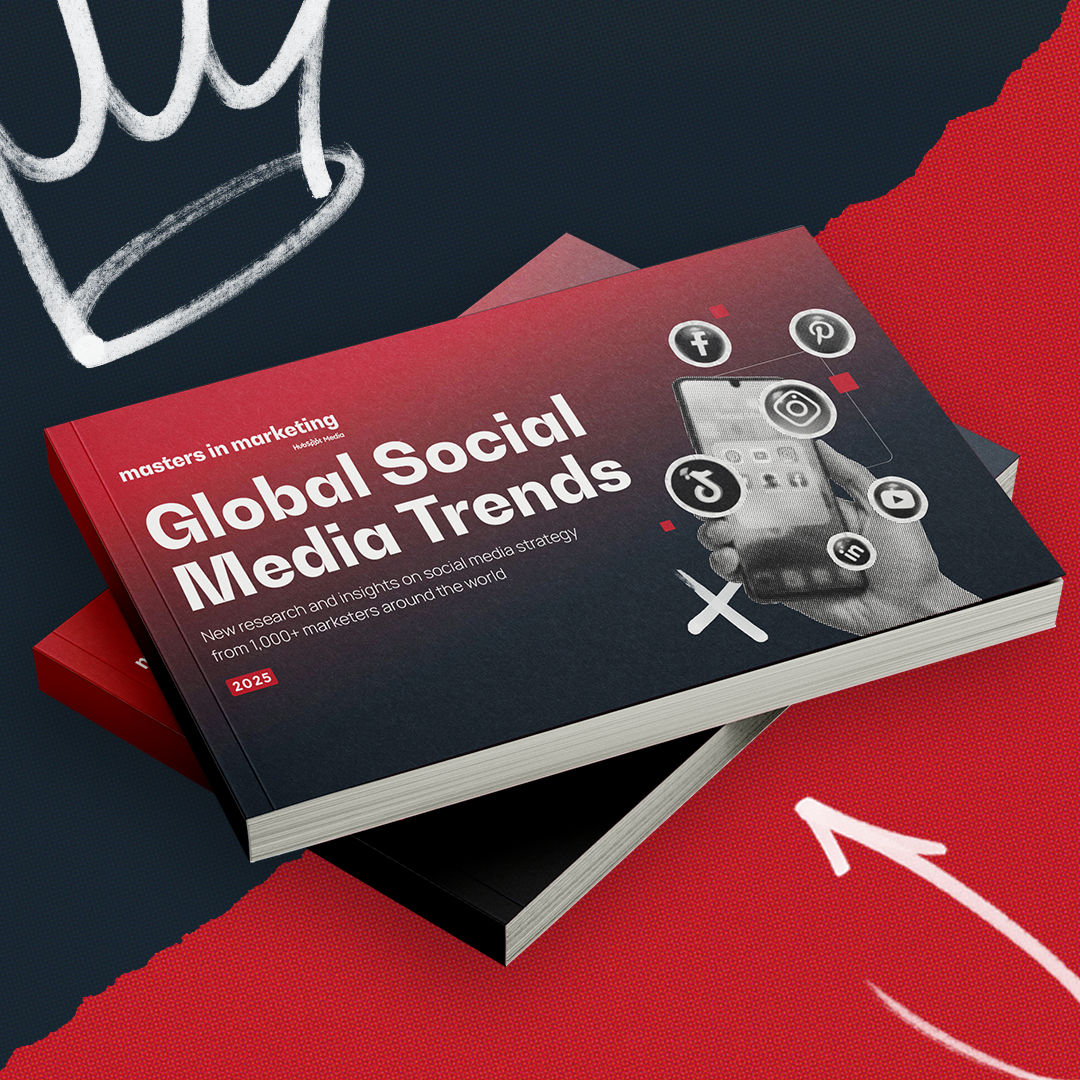
![The most effective types of content on social media in 2025 [new data]](https://53.fs1.hubspotusercontent-na1.net/hubfs/53/Copy%20of%20Featured%20Image%20Template%20Backgrounds%20(16).png)



![12 social media trends marketers should watch in 2025 [new data]](https://53.fs1.hubspotusercontent-na1.net/hubfs/53/social-media-trends_6.webp)
![The best social media platforms for video content in 2025 [consumer data]](https://53.fs1.hubspotusercontent-na1.net/hubfs/53/img-1-20250516-9399498.webp)

-1.jpg)

![Social media shopping in 2025: Everyone’s shopping on social — here’s how marketers can keep up [new data]](https://53.fs1.hubspotusercontent-na1.net/hubfs/53/1052%20x%20850%20social%20media.jpg)